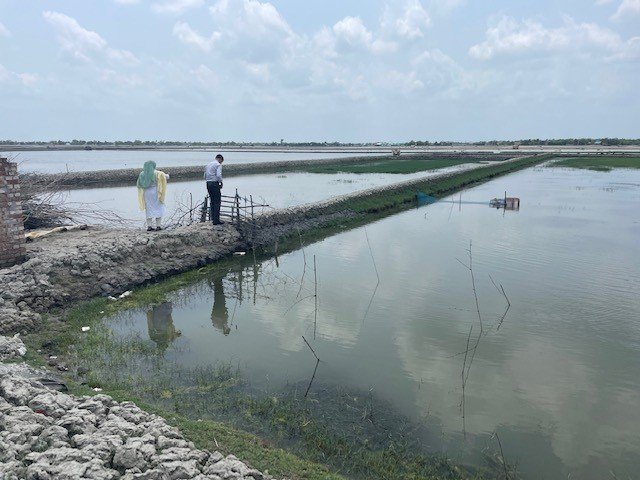On site with SNV Project Manager Albert Bokkestijn
Bangladesh is a dynamic country with an active private sector and a population of more than 170 million people. Recently, members of the Dutch Fund for Climate and Development consortium visited the country. For the likes of Aart Mulder, who last visited seven years ago, there have been tremendous changes in urban and rural areas.
Bangladesh is a priority country for the DFCD. Despite the economic progress, it is still considered an LDC (Less Developed Country) and is very vulnerable to climate change. While we were there, we witnessed early heavy rainfalls affecting the rice harvest in the Southwest of the country, and heavy flooding in the Northeast.
Growing opportunities
Currently the DFCD is supporting the development of two investments proposals in Bangladesh. This is being managed by the DFCD’s Origination Facility, by SNV Netherlands Development Organisation.
- Ispahani is developing an investment proposal to introduce and scale climate resilient seeds and bio-pesticides into the company’s ‘One Stop Agriculture’ platform. Find out more here.
- ACI Agrolink is developing a business proposition on climate resilient black shrimp value chain development.
In addition, there are several initial proposals submitted to the DFCD to scale-up climate-resilient solutions to achieve impact in the food and water sectors, which are currently being assessed.
During our time in Bangladesh, we observed that many companies in the agribusiness sector, as well as financial institutions, consider climate change action a priority for their business. They recognise this means adjusting their business and/or operating model.
Witnessing successes and challenges
At the field visit to an area where Ispahani is working, we saw many destroyed rice paddies due to recent floods. The farmers had not yet harvested, nor did they use seed varieties that allow for earlier harvesting (which are provided by Ispahani).
We also noticed that using biological inputs and simple tools (such as small bags protecting and improving quality growth of mango fruits), food production substantially increases. Tomatoes are currently endangered by a small fly, which is creating diseases. Bio-pesticides to tackle this disease will prove to be a success.
Improving shrimp farming techniques
We also visited one of ACI Agrolink’s shrimp processing plants, AMIAN. The company started in 2019 and has increased substantially over the last two years. Following international standards on the export market, with ‘almost endless’ demand, there is a huge focus on supply. Half is sourced directly from small farmers, while the other half from other suppliers.
ACI Agrolink works on an e-traceability system. Within the shrimp value chain, both the company and the input provider provide training and quality control, and micro-finance is being piloted to smallholder farmers. Every farmer is EU registered and the Bangladesh authorities controls quality intensively.
Thanks to the involvement of ACI Agrolink, farmer incomes (most of them being women) has improved substantially. Shrimp farming is attractive, but there is an urgent need to improve farming techniques to manage water quality and disease control.
Nearby the shrimp farming areas are critical mangrove areas. Mangroves provide opportunities for conservation and restoration. There is an interlink with the shrimp business which could be assessed.
Smaller investment opportunities
In improving the climate resilience of smallholder farmers in the Delta, the DFCD aims to explicitly support scalable solutions. A challenge we face is that many innovative and greenfield investments require smaller investments than the DFCD facilities are providing. During the trip to Bangladesh, we reached out to local banks and insurance companies to assess two options:
- Investigate interesting local SMEs to graduate for Bank lending with DFCD supported technical assistance and loan facilities.
- Scaling successful concepts of crop insurance, without subsidy.
Altogether it was great to see that DFCD is making good progress working on scalable climate resilient investment proposals. Some business models have good potential to identify additional investments propositions that could be supported by the DFCD in an anticipated second phase (expected to be launched in 2023 or 2024).
|
Climate vulnerability Sea-level rise is projected to increase the salinity of the water and soil of the now-fertile Ganges Delta, endangering crops and threatening food security. By 2050, scientists estimate that sea-level rise in the delta could directly affect more than three million people, and Bangladesh could lose nearly one-quarter of the land area it had in 1989 by 2100, under a worst-case scenario. Salinity intrusion in the coastal region of Bangladesh results from a combination of factors, including sea level rise, cyclones, storm surges, decreases in upstream freshwater flow, and variability of rainfall. Models indicate that sea level rise and climate-induced intensified cyclones are projected to increase the pace of salinization processes. A World Bank study also showed that due to sea level rise and other climatic conditions, salinity will move further inland with Bagerhat, Barguna, Bhola, Jessore, Khulna, Satkhira, Patuakhali, and Pirojpur becoming extremely vulnerable. With climate change amplifying current trends of salinity intrusion in ground and surface water aquifers and soil, this is causing a significant impact on agricultural productivity and freshwater availability. These impacts will be further exacerbated through more regular extreme weather phenomena like cyclones and increased floods. Higher temperatures in combination with changing precipitation patterns can increase the risks of floods and droughts. While most of the country is typically susceptible to river and rainwater flooding, low-lying coastal areas remain vulnerable to tidal flooding. Climate change is projected to intensify the impacts of inundation events driven by changing rainfall patterns, temperatures, cyclone events, and sea level rise. |

